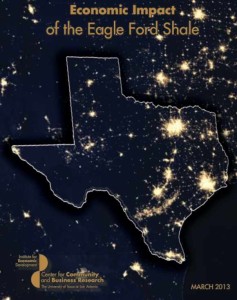With the 83rd Legislature in session, legislators have a unique opportunity to address county transportation infrastructure needs during this transformative time in South Texas. All eyes are on Texas -- and the Texas legislature as it develops solutions -- for good reason. Texas is known for our innovative platforms, our reinvestment methods and a collaborative spirit that is at the very core of being a Texan.
Cities and counties are forging strategic alliances pertaining to productive development of the Eagle Ford shale region; educational institutions from across the region are ramping up science, technology, engineering and mathematics (STEM) coursework to meet the growing needs of the industry; and communities are attracting increasing numbers of small businesses, new residents and visitors.
The Eagle Ford Is Bringing Economic Prosperity
South Texas is fortunate to be experiencing the benefits of expanded oil and gas activity, astutely described by Forbes as “the blessing that is the Eagle Ford Shale.” Access to bountiful natural resources in this region is truly a “blessing” whose impact will be pronounced for many generations of Texans. But with this opportunity comes a very real need to create and sustain critical infrastructure to meet the growing community and industry’s needs, including roads, housing, medical facilities and other basic necessities.
“Texas is in a favorable growth position as evidenced by the continually-developing Eagle Ford Shale region.”
STEER and its founding members -- Anadarko, Chesapeake Energy, ConocoPhillips, EOG Resources, Lewis Energy Group, Marathon Oil, Murphy Oil Corporation, Pioneer Natural Resources Company, Shell Oil Company, Statoil and Talisman Energy -- are committed to working with our South Texas leaders to identify and share solutions to support and enhance the vitality of the region. The STEER founding members invested more than $12 million in 2012 for a variety of infrastructure needs in South Texas. County officials are limited in their ability to raise funds necessary to repair and maintain impacted county roads. STEER will continue the dialogue with stakeholders in South Texas to assist with finding solutions that will ensure continued prosperity and economic development for the region.
STEER Will Collaborate With Local Communities
Texas is in a favorable growth position as evidenced by the continually-developing Eagle Ford Shale region. The timely release of the University of Texas at San Antonio’s Institute for Economic Development March 2013 report on the Economic Impact of the Eagle Ford Shale, states that the shale now ranks as the largest single oil and natural gas development in the world based on capital expenditures by companies in the industry. Wood Mackenzie Ltd. has calculated that the oil and natural gas operators active in the Eagle Ford Shale will spend $28 billion in 2013, up 68 percent from the $19 billion spent in 2012.
Collaboratively, STEER local community leaders, and state elected officials must work together to promote long-term investment and sustainability in South Texas. Infrastructure improvements and investments made today will pay off many times over, as unprecedented economic impact brings a renewed spirit into South Texas.
By Omar Garcia, President, STEER - South Texas Energy & Economic Roundtable
As President of the South Texas Energy & Economic Roundtable (STEER), Omar Garcia facilitates communication, education and public advocacy surrounding the production of energy resources in the Eagle Ford Shale Region and all of South Texas.




